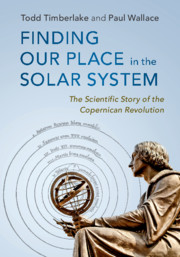Book contents
- Frontmatter
- Dedication
- Contents
- Preface
- 1 Introduction: mysterious skies
- 2 Two spheres: modeling the heavens and the Earth
- 3 Wanderers: the Moon and the planets
- 4 An Earth-centered cosmos: astronomy and cosmology from
- 5 Moving the Earth: the revolutions of Copernicus
- 6 Instruments of reform: Tycho’s restoration of observational
- 7 Physical causes: Kepler’s new astronomy
- 8 Seeing beyond Aristotle: Galileo’s controversies
- 9 The system of the world: Newton’s universal physics
- 10 Confirming Copernicus: evidence for Earth’s motions
- Appendix Mathematical details
- Notes
- References
- Index
9 - The system of the world: Newton’s universal physics
Published online by Cambridge University Press: 18 March 2019
- Frontmatter
- Dedication
- Contents
- Preface
- 1 Introduction: mysterious skies
- 2 Two spheres: modeling the heavens and the Earth
- 3 Wanderers: the Moon and the planets
- 4 An Earth-centered cosmos: astronomy and cosmology from
- 5 Moving the Earth: the revolutions of Copernicus
- 6 Instruments of reform: Tycho’s restoration of observational
- 7 Physical causes: Kepler’s new astronomy
- 8 Seeing beyond Aristotle: Galileo’s controversies
- 9 The system of the world: Newton’s universal physics
- 10 Confirming Copernicus: evidence for Earth’s motions
- Appendix Mathematical details
- Notes
- References
- Index
Summary
In 1671 Robert Hooke thought he had detected an annual parallax for the star Gamma Draconis, thus proving that the Earth orbits the Sun. Setting aside the uncertainty of Hooke’s meagre measurements, there remained the problem of how the Earth could orbit the Sun. Hooke thought he knew: the planets orbited the Sun because of a combination of straight line inertial motion and an attraction toward the Sun. But it was left to Hooke’s rival, Isaac Newton, to work out the mathematical details. While working out these details Newton established an entirely new physics based on three fundamental laws of motion and a universal gravitational attraction between all massive objects. Newton’s physics explained not only the orbits of planets, but also the motion of projectiles, the orbits of the Moon and comets, the precession of the equinoxes, and the tides. Newton’s physics was hailed in England but many European natural philosophers initially dismissed universal gravitational attraction as an “occult quality.”
Keywords
- Type
- Chapter
- Information
- Finding our Place in the Solar SystemThe Scientific Story of the Copernican Revolution, pp. 247 - 280Publisher: Cambridge University PressPrint publication year: 2019



